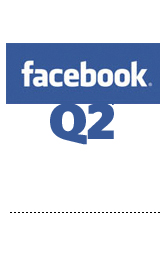 Facebook reported second-quarter earnings on Thursday amid generally high expectations for the company’s advertising business, especially as it pertains to mobile and video. Investors were not disappointed.
Facebook reported second-quarter earnings on Thursday amid generally high expectations for the company’s advertising business, especially as it pertains to mobile and video. Investors were not disappointed.
Facebook posted Q2 advertising revenue of $2.68 billion, a 67% increase from Q2 2013. Of that, mobile advertising is becoming increasingly important – it constituted 62% of Facebook’s total advertising revenue in Q2 2014, up from 41% in Q2 2013. Read the earnings release.
Ad prices spike, unlike Yahoo. On the company’s earnings call, CFO David Ebersman said Facebook’s ad volume fell during the quarter as a result of the rapid consumer shift to mobile (and, hence, news feed-only ad placements).
Meanwhile ad prices rose as well, driven by that very same shift to news feed inventory, which is more expensive. (Incidentally, it’s exactly the opposite dynamic that Yahoo experienced in its most recent quarter; Yahoo’s volume rose while CPMs fell.)
Ad prices are also rising for right rail inventory as Facebook pushes a redesign featuring more prominent ad formats within that real estate. COO Sheryl Sandberg added that these ads are getting higher engagement rates than their predecessors, and can be presumed to be more effective.
Mobile install color. Facebook doesn’t break out revenue or impression volume for its mobile app install ads formats, which seek to drive downloads of mobile games and other app experiences. Sandberg sought to portray mobile ad revenue as diversified across a wide range of advertisers. “Sometimes people think mobile app install ads are the great majority of revenue. They’re not,” she said. “Mobile ad revenue is broad-based. We have large brand advertisers, small SMBs and developers.”
Slo-mo video. Analysts have looked favorably on Facebook’s investments in video, evidenced by its experiments with auto-play ads in the news feed (it has run about 12 campaigns so far) and its acquisition of LiveRail this month for an estimated $500 million. Asked about the LiveRail deal in particular, Sandberg said LiveRail would essentially support Facebook’s ad network, launched in May. “With the [Facebook] Audience Network we have an opportunity to increase ad relevance for publishers. We see [LiveRail] as an opportunity to increase reach and relevance of ads on and off Facebook,” she said. In other words, it’s all about extending Facebook ad revenue off its O&O properties.
However Facebook is clearly still in the warm-up stages of its auto-play video experiment. CEO Mark Zuckerberg said it wants to accelerate organic video sharing before dialing up paid video media, and that takes time. “We’re trying to ramp up the amount of public content people share at the same time that we’re ramping up auto-play video ads. Also, we want to be sure we don’t overconsume people’s data. In a word, we’re focused on quality.”
Keep on measurin’. Facebook will also stay focused on its partnerships to track the offline impact of its ads. Here’s Sandberg:
“We’ve done a lot of work over the last year or two on measurement. Investing in measurement and connecting not just online to online but online to offline is super important. … We have an advantage in that we have real identity across desktop and mobile. We have relationships with third parties to connect offline and online sales to online ads and those investments remain a very big focus for us.”
Keep on growin’. Audience growth is still strong. Facebook’s daily active users (DAUs) increased 19% year over year to 829 million. Mobile DAUs increased 39% year over year to 654 million. Monthly active users (MAUs) increased 14% year over year to 1.32 billion, and mobile MAUs increased 31% year over year to 1.07 billion.












